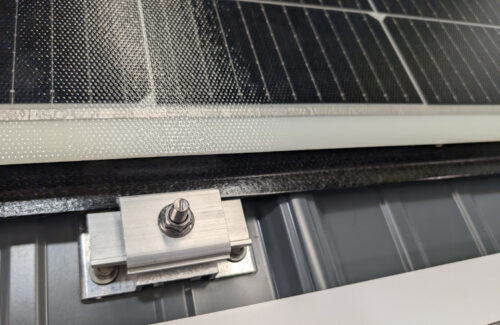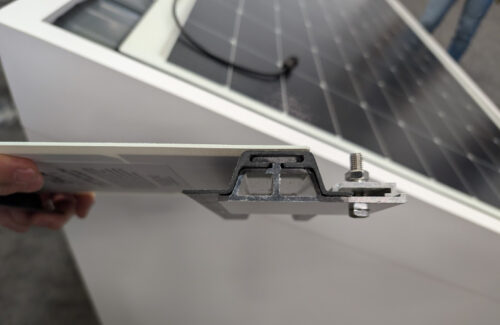When it comes to the solar panel technology space, there’s honestly not much to talk about. Everyone seems pretty comfortable in the PERC and TOPCon camps, making sure they have a panel for each market. Every panel manufacturer booth at the RE+ trade show seemed to have at least one bifacial panel, one ‘smaller’ module for the residential market and large panels for large scale use (one way or another) using both M10 and G12 cell designs. Much of the talk at this year’s show focused on domestic manufacturing and policy changes, but I was able to spot some exciting developments in technology.
Bila Solar
Bila Solar first announced its intention to build a gigawatt-scale manufacturing plant in Indianapolis last year, and the company brought its first glassless, frameless silicon solar panel design to RE+ 2023. That first-generation panel – just 17 lbs and composed largely of layers of EVA – would be attached via adhesive to commercial roofs, and Bila is still tailoring that design to America’s various roofs. Now the company is developing version 2 of the panel, just in time for the start-up of the domestic production site in December. This panel features a composite “substructure” on the underside that acts as a frame, allowing Bila-designed clamps to be attached to rails or to mountings on standing seam metal roofs. This only pushes the weight of the panel to 25 lbs, making it still a great option for roofs with weight issues, but offering more options for how it is installed.
Silfab

Silfab plans to begin producing solar cells at its new South Carolina factory early next year, and one of the first domestic designs will be the highly anticipated Elite module. A conductive backplate is coupled with back-contact solar cells and strategically placed connection points. The all-black panel, without rails, would be a very aesthetically pleasing choice for private customers, but the unique cell design must come first. The Dept. of Energy is interested in this technology: the government has awarded Silfab $5 million to develop the back contact cells at its new production site in South Carolina. Silfab contributes to the design of the back plate SunFlexanother DOE grantee who started at Arizona State University. IBC designs are probably the next best thing after TOPCon, so Silfab could be well on its way to the next breakthrough development in solar panels.
Trina Solar

A few solar panel companies have been working to improve the hail resistance of their bifacial designs, and many have found that simply increasing the thickness of the front glass from 2mm to 3.2mm works quite well. But that 1.2mm jump in glass thickness adds a not insignificant amount of weight to the panel. So instead of just offering double-glazed bifacial designs, Trina Solar developed a version of its Vertex N product with the thicker front glass but a clear back plate. The ambidextrousness still works, and the lighter weight helps installers and the structural integrity of the module itself, which in turn helps provide strength in hailstorms. Trina found that the 3.2mm/backsheet modules could withstand larger hailstone sizes and more tilt angles than the 2mm double-glazed modules. It’s an interesting design consideration because more solar is being installed in more temperamental areas as climate change affects weather patterns.
Imperial Star Solar

I’m a nerd for good product illustrations, so I wanted to make sure everyone saw this deconstructed solar panel from Imperial Star Solar. Solar panels are a cool piece of technology, and I hope to see more progress in this area soon.




